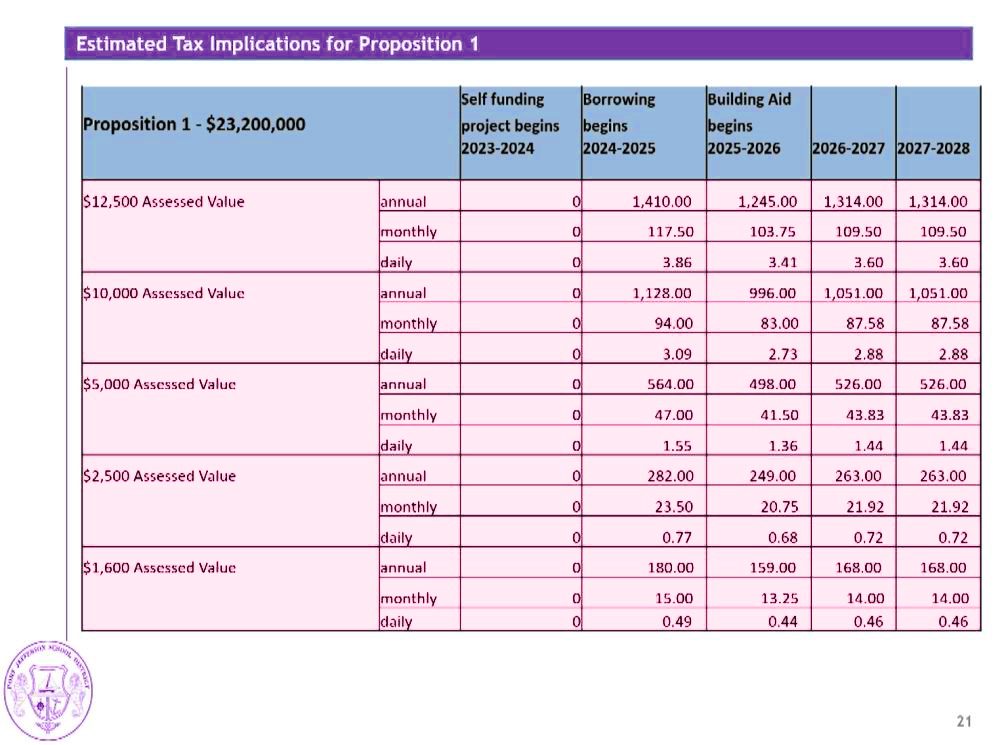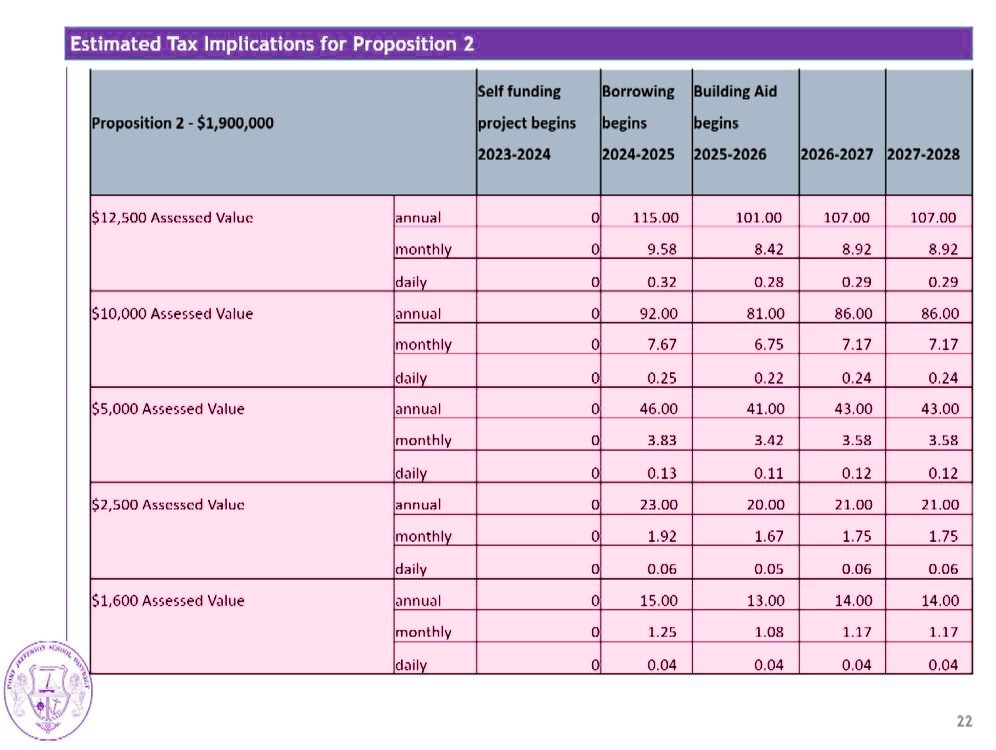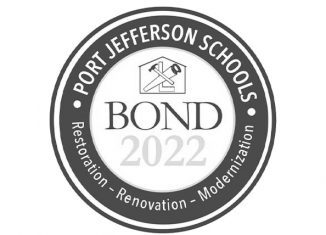PJSD administrators present proposed capital bond projects and cost estimates
During a special meeting of the Port Jefferson School District Board of Education on Tuesday, Sept. 6, superintendent of schools Jessica Schmettan delivered a presentation on the proposed capital bond projects slated for a possible public referendum later this year.
During the upcoming meeting on Tuesday, Sept. 13, the board will vote whether to formally adopt two ballot propositions for an expected Dec. 12 vote. The special session included a lively discussion among board members and elicited significant feedback from members of the public. Village Mayor Margot Garant even made an appearance to share her own take on the proposed projects.
The meeting began with a detailed presentation of the proposed projects, followed by over an hour of deliberations during the public comments. Both ballot measures drew considerable public debate and diverse perspectives from both sides.

Proposition 1
Proposition 1 encompasses a wide range of infrastructural improvements across buildings throughout the district. The estimated combined costs for Proposition 1 total $23.1 million.
The first item includes upgrades to heating and cooling within the high school and elementary school, upgrading the steam heating system and providing dual-use ventilators in the high school. The plans would also replace existing units in the elementary school with dual cooling units.
“If this bond was to be approved, we could say that all three of our schools would be heated efficiently and cooled efficiently,” Schmettan said. “I know there has been some conversation about cooling and the need for that. It is a modern convenience, but it is also a comfort. … It is tiring to be in the heat that long, and our students do learn best when they are in the most comfortable conditions.”
The proposal would also renovate the existing locker room and team room facilities surrounding the high school gymnasium. These facilities are used by physical education classes from grades 6-12, supporting the nurse’s office and the well-fit rooms.
The proposed renovation to the nurses’ office would remove an existing wall, adding a waiting area, a resting place, an ADA-compliant toilet and sink, and a resting area for the nurses.
The ballot proposal also seeks to reconfigure the girls locker room and team rooms, repurposing some of the existing showers as additional locker room space. The proposal would link the girls locker room with the team room and an ADA-compliant bathroom.
“Additionally, there would be access from the Wall of Fame hallway so that children could get into the team room, get into the locker room, without walking through the gymnasium when classes are in session or games are in session,” the superintendent said.
The proposal adds plans for a wellness room, which will open up storage space for the physical education department. A wellness room, according to Schmettan, would centralize equipment storage while accommodating office space for PE teachers and coaches.
“It centralizes everything,” Schmettan said. “Right now, our boys team room is upstairs and our girls are downstairs. It centralizes all our staff in one spot for supervision, which is ultra-important.”
Transitioning to the boys team room, Schmettan expressed disappointment and embarrassment at the existing facilities. She indicated that this space is “old and decrepit,” with a “long, dark hallway.” The current layout has the added disadvantage of separating the boys and girls team rooms between separate floors.
The proposed renovations would bring the boys team room downstairs. Similar to the layout for the girls, the boys team room would conjoin the team room with the locker room while providing access from the hallway.
Currently, the school trainer uses a closet as an office space. Under the plans, the trainer would move out of this location into a repurposed and renovated well-fit room. “It has access from the hallway and can be a proper room for the students to see the athletic trainer for any of their injuries,” Schmettan said.
Another aspect of this bond proposal centers around the two areas where the students have to leave the main building to access a portable that houses art, technology and music programs. To get to the portable, students must exit the building and mount a steep set of stairs, often encountering inclement weather.
“It is a huge safety and security issue,” Schmettan said. “It also presents a problem when you’re talking about students with disabilities, or with short- or long-term injuries.”
The bond proposal would demolish the portable music room, outfitting the upstairs space that supports the boys team room with a new tech education room and music room.
The existing band and choral room would also improve, with proposed renovations to the storage areas for equipment and musical instruments.
The final item within Proposition 1 is the renovation of approximately 14 bathrooms within the elementary school. These upgrades include tiling, plumbing, toilets, sinks and water fountains.

Proposition 2
The second ballot proposal, if approved, would replace the existing grass athletic field with an athletic turf field. A projected $1.88 million project, Proposition 2 would add a five-sport lined crumb rubber surface, which has an expected lifespan of eight to 12 years.
Schmettan said a turf field would promote playability for the district’s athletic teams. She added that despite some speculation from members of the public, there are no plans for either field lights or a comfort station for the turf field.
Proposition 2 is a contingent ballot measure, meaning it cannot pass on its own. If the first proposal were to fail come December, then the second proposal would fail automatically regardless of its vote.
Cost estimates
Joining Schmettan was deputy superintendent Sean Leister, who presented multiple financial models to prepare district residents for the expected costs for these projects.
Leister said his estimates generally swayed on the conservative side so that he does not underrepresent the expected costs. His models assume construction will begin in 2023-24 and that the district will borrow funds from its reserves to cover the expenses for the first year of the bond.
“We would borrow money for a 15-year bond,” he said. “Once again, that could be variable, but we’re using an estimate of 15 years. The debt service on that bond would run from 2024-25 through [2038]-39.” He added, “In my models, I also estimated that state aid would not begin until the third year. … I also estimated on the low side that 87% of the project will be eligible for state aid.”
Leister gave a detailed estimate of residents’ annual contributions to paying down the bond based on the assessed values of their homes. Since the project’s first year will be self-funded, borrowing will kick in for 2024-25. See figures above for expected costs from 2023-28.
Following the presentation, a spirited discussion ensued during the public comments when district residents, parents and students raised several arguments for and against the two ballot measures.
To watch the public comments (starting at 46 minutes, 10 seconds), click here.







